
Oregon Spring 2021 Turkey Hunting Forecast
THE FOLLOWING ARE EXCERPTS FROM THE OREGON DEPARTMENT OF FISH AND WILDLIFE’S 2021 SPRING TURKEY HUNTING FORECAST
Turkey hunting opportunities have expanded significantly in the last 20 years. Hunters can now find good turkey hunting beyond just southwest Oregon and into the northwest and northeast parts of the state as well.
Last year’s estimated spring harvest of 6,589 turkeys was up 17.7 percent from the previous year, the highest harvest on record. Turkey production and survival were not limiting factors in 2020. Expect good to excellent habitat conditions and thriving turkey populations in most of the state this year.
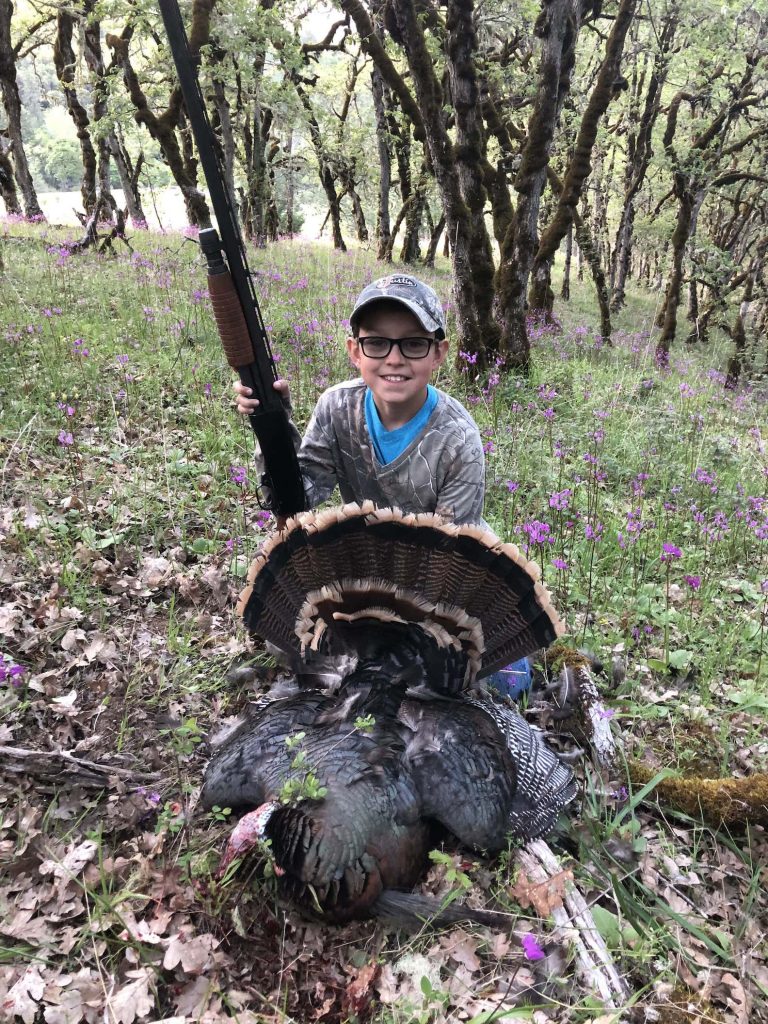
Hunting access in 2021
The 2020 wildfires impacted large swathes of public land, some of which may remain closed during the hunting season.
Be sure to contact the agency that manages the land you to hunt on, and confirm access before you head out to hunt.
State lands
Oregon Department of Forestry manages Oregon state forests.
Oregon Department of Fish and Wildlife manages state wildlife areas.
Federal lands
US Forest Service lands have remained open to hunting and many campgrounds have reopened.
BLM lands have remained open to hunting.
Where are the turkeys?
Southwest Oregon leads the way
Southwest Oregon continues to be the leading place to find turkeys. The Rogue, Melrose, and Applegate units have the highest turkey harvest in the state, however hunters had to work harder to be successful in the Rogue. Hunter use on the Rogue Unit is second only to the White River Unit. The lack of public land in the Melrose Unit can make hunting difficult (just 16 percent of Melrose is public land and some private land is tied up by leases).
Those who want to hunt southwest Oregon may have an easier time accessing land in the Rogue Unit, which is 57 percent public lands, or other leading units like Applegate or Evans Creek. While a lot of turkey harvest in the Rogue is on private land, there is good turkey habitat in the Jackson Cooperative Travel Management Area and some US Forest Service land. See the Jackson County report below for more information.
ODFW is working to increase accessible turkey hunting throughout Oregon. This winter, biologists relocated approximately 800 nuisance turkeys from private land to public lands or publicly accessible areas.
ODFW is expanding a pilot project to connect turkey hunters with private landowners experiencing turkey damage on their property, primarily in the Willamette Valley and Roseburg area. Reservation dates will be released weekly on a rolling basis throughout the season. Learn more here.
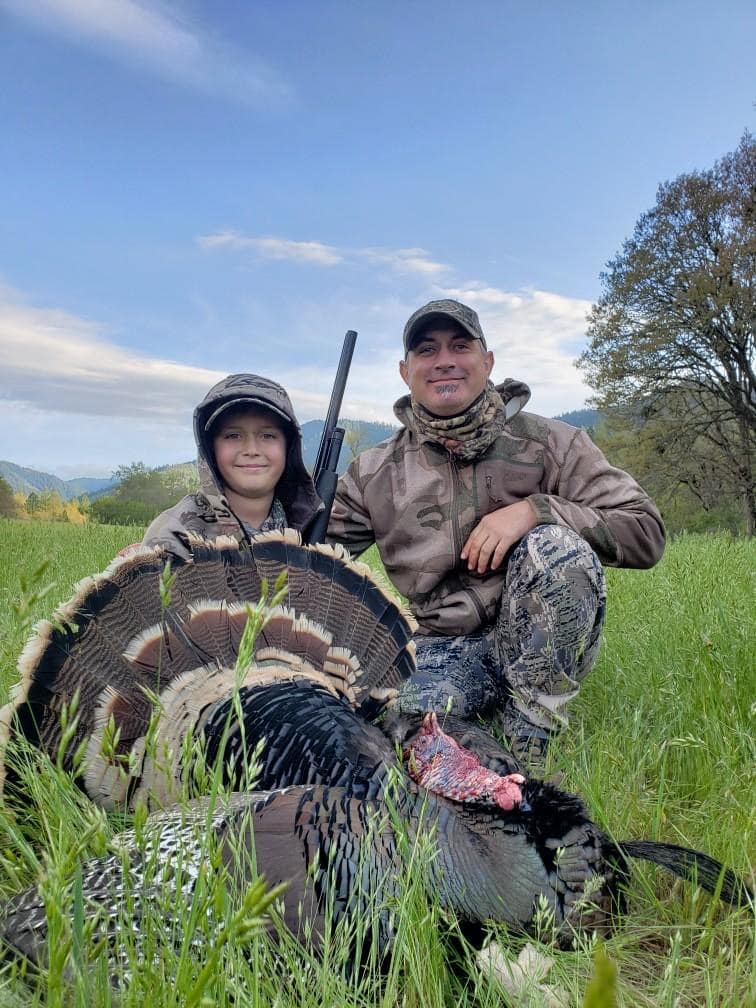
Don’t forget about eastern Oregon
orty-four percent of the turkeys harvested during the spring 2019 season were harvested east of the crest of the Cascade Mountains. The White River Unit continues to lead in hunting pressure (6,432 hunter-days), and ranked third in overall harvest level (439 birds). Biologists advise scouting in advance, hunting on a weekday or waiting until later in the season for the best experience in White River Unit.
After White River, Heppner, Northside, Murderers Creek, Sled Springs and Mt. Emily were the highest performing units in terms of total harvest, and individual hunter success rates are generally better in the northeast part of the state.
Many northeast Oregon birds are found on public lands, particularly national forests. In most years, birds can take advantage of open southern exposures at higher elevations before the hunters can get to them.
Finally, if you have access to private land, hunting can be excellent in northwest Oregon. Last year, the Willamette Unit ranked fifth in total harvest and the McKenzie ranked seventh.
It is important for hunters to check road conditions and access before heading out, especially early in the season. Snow may limit access to some areas.
2020 turkey harvest by unit
Harvest and effort data can help you identify promising places to hunt. This article on MyODFW.com includes maps showing harvest, hunter days, birds per hunter and percent of birds harvested on public land.
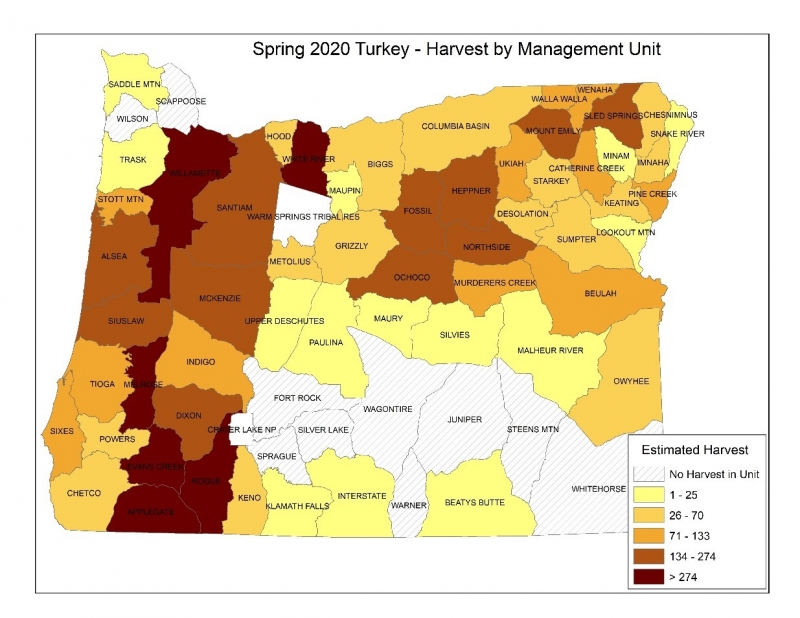
NORTHWEST AREA
NORTH AND MID-COAST
Stott Mt. and Alsea Units
Turkeys are only found on the east side of the coast range in these units. The best place to find turkeys is on the private agricultural lands with rolling oak woodlands adjacent to the larger private timber holdings. However, less dense populations of turkeys can be found on timber company grounds. The east side of the Stott Mtn – N Alsea TMA is one easily accessible area to scout for turkeys.
Additionally, some of the smaller timber companies in these units will allow access with a free permit and can hold decent numbers of turkeys. Potentially accessible lands outside the towns of Monroe, Alsea, Philomath, Blodgett, throughout Kings Valley, Falls City, and Dallas are good places to scout. Remember to get permission to hunt on private land.
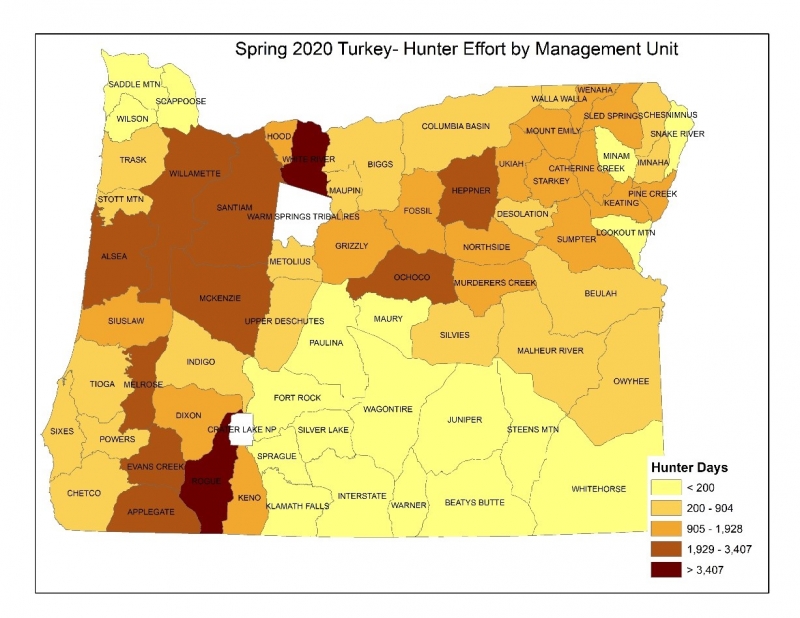
WILLAMETTE UNITS
Trask and Willamette Units
Finding a place to hunt is challenging in northwest Oregon. Turkeys are primarily found on private lands and are not readily available to the public. Those hunters without local contacts should be out talking to landowners to acquire access to the few and widely scattered flocks. Some hunters knock on landowners’ doors where they see turkeys and ask permission to hunt. Recent reports of turkey activity in the eastern foothills of the coast range highlight limited opportunity on predominantly private lands. To find public land opportunities, consult Bureau of Land Management (BLM) or U.S. Forest Service maps and look for pockets of public land off the main roads, but adjacent to agricultural land and mixed hardwood forests — turkeys key in on both acorns, and grubs and other insects in meadows.
Scappoose Unit
Turkey populations are extremely low and not widely distributed. Hunters will need to have scouted early to find turkey flocks and obtained permission to hunt on private property to be successful.
Santiam, N. Indigo, and McKenzie Units
Hunting success is dependent upon securing access to private lands with turkeys, and on early scouting. Hunters who are having issues gaining access to private lands are advised to participate in ODFW Hunt by Reservation Program. Turkeys are most often found on private lands in the foothills along the west side of these units. It is uncommon to find turkeys in the Douglas-fir forests at higher elevations.
For hunters that have done their homework and obtained access to private lands, hunting can be very good in the McKenzie, N. Indigo, and southern portions of the Santiam units. Turkey are not abundant in the northern portions (north of Silverton) of the Santiam Unit and hunters will have difficulty finding the few scattered flocks.
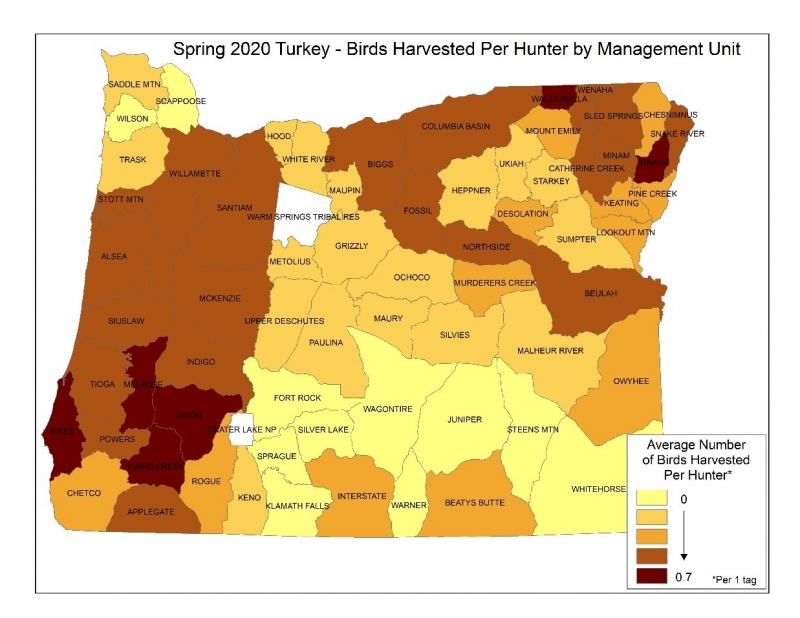
SOUTHWEST AREA
COOS COUNTY
Winter conditions in 2019-20 were conducive to high survival for turkeys. Also, over the past several years turkey numbers appear to be increasing and the distribution of flocks has clearly increased. That said, the vast majority of flocks spend most of their time on private land because habitat types on most public lands are not productive for these birds.
Gaining permission to hunt on private land is clearly the most effective way to hunt turkeys in Coos County. However, looking for pockets of public land that are in close proximity to private land birds can be a productive tactic for hunting these birds too. In Coos County much of the BLM lands are scattered small tracts of land surrounded by private lands.
Turkey abundance is highest in the vicinity of Coquille, Myrtle Point, Powers, and Fairview but there are a few turkeys in other parts of the county, as well. Scouting for turkeys before the hunt is key to finding them especially if hunting public land or private timberlands.
CURRY COUNTY
The turkey population has been low for several years. Reproduction along the coast is often slower than inland areas; survival is harder with the rains that occur here. Hunters will need to have scouted early to find turkey flocks and obtained permission to hunt on private property. Look in areas where oaks and grassy prairies and taller timber for roost sights are found.
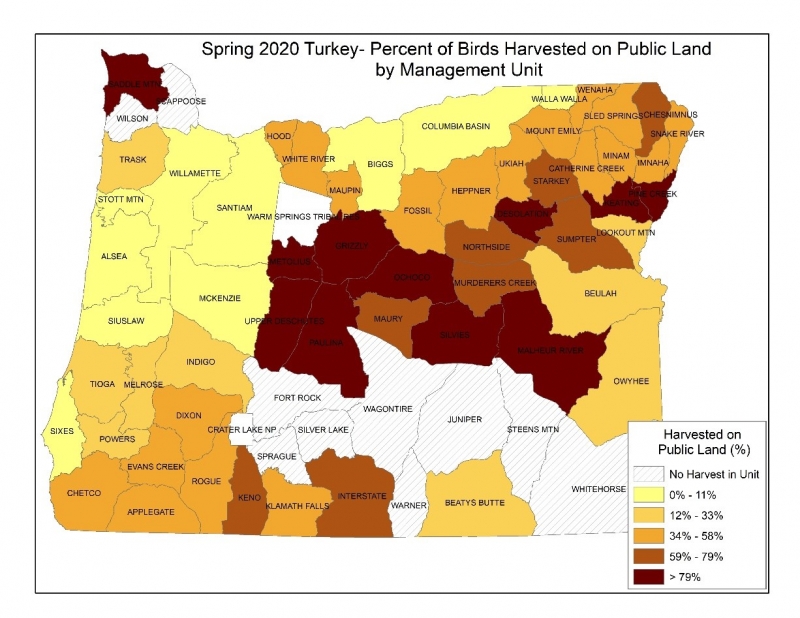
DOUGLAS COUNTY
e experienced mild weather this winter and early spring, which should bode well for turkey survival coming into the 2021 spring season. With warm temperatures in March lots of early breeding behavior was observed. If the current weather trend continues, hunters should encounter plenty of active toms.
Douglas County has a strong turkey population due to an abundance of oak-savannah and oak woodland habitat in the low-mid elevation Umpqua Valley. ODFW has also supplemented prime habitat within the Umpqua National Forest with turkeys over the last several years. There is public hunting opportunity on the Umpqua National Forest, especially in the South Umpqua. Turkeys can be found in mixed oak woodlands in the national forest. There are a few Roseburg BLM lands adjacent to private lands, like N. Bank Habitat Management Area, offering excellent opportunities for hunting in low elevation oak savannah habitat, which is great for turkey.
If you are looking for a private lands hunt, asking for permission later in the season, after landowner’s friends, family and guides have hunted, sometimes gets results. It can be hard for a regular hunter to gain access on some private property on the valley floor because some landowners work with guides that have clients that hunt exclusively on their property.
This past winter, several hundred birds causing nuisance or damage issues were trapped and relocated to public lands within Douglas and Klamath Counties.
JACKSON COUNTY
This year’s turkey numbers remain strong, and hunting is expected to be above average. Turkeys can be found feeding on green grasses and insects in and around open forest floors, under oak canopies. A great strategy to locate turkeys in an area is to use locator calls (crow calls or turkey calls) before light or after dark to identify roosting trees. Come back to that area in the early morning, before daylight, and set up in an area of their travel to begin calling as light approaches.
Turkey flocks continue to be found in a wide variety of places in Jackson County. While most turkeys will be found on private lands, plenty of public lands have turkey, including grassy/oak savannas on BLM lands and lower elevation timber/meadow lands of the Rogue National Forest. The best areas in the Rogue Unit to hunt would be all the roads along the Butte Fall-Prospect Hwy between Butte Falls and Prospect. Other spots are found in areas within the Jackson Cooperative Travel Management Area map.
JOSEPHINE COUNTY
Turkey numbers in Josephine County remain very strong. Hunting is expected to be good to above average. Turkeys can be tough to hunt in the county as most are found on private property. Don’t be afraid to ask landowners to hunt on their property; turkeys can be a problem for many landowners that grow crops and they may be willing to allow hunters to come and hunt turkeys to reduce damage. Most turkeys are found along the Applegate River and Evans Creek drainages, but turkeys can also be found on most BLM lands. Try areas off of Galice road.
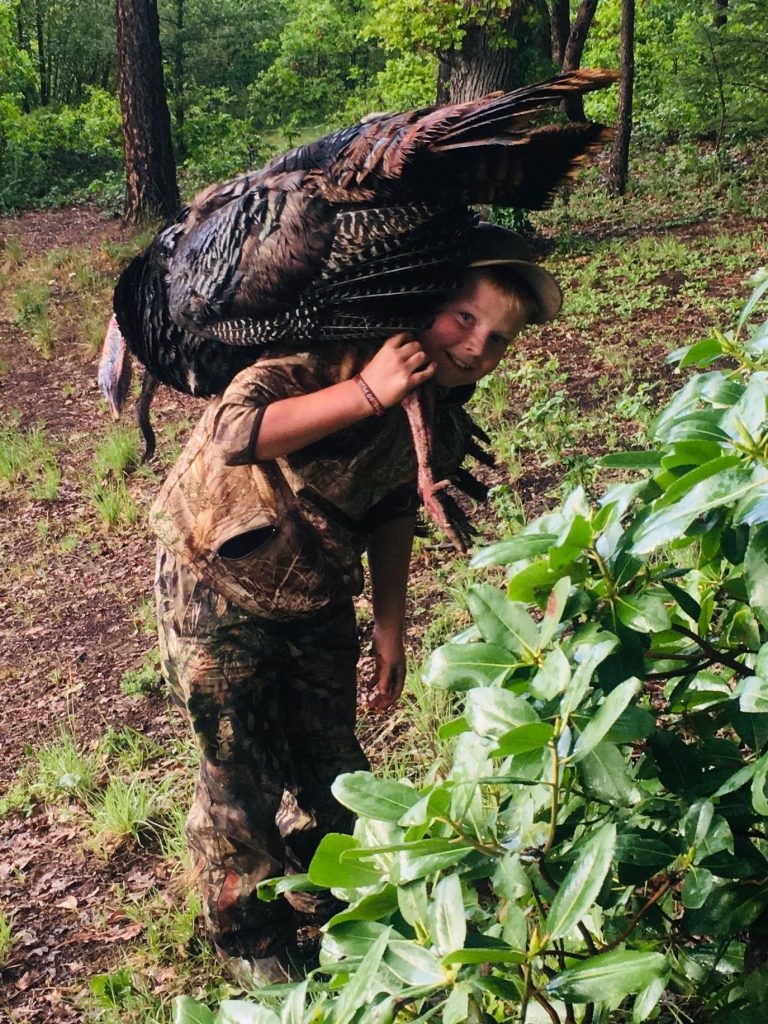
COLUMBIA AREA
White River and Hood Units
Access in the White River and Hood units should not be much of an issue this year. Snow at lower elevations was mild throughout most of the winter. Access to most of the best turkey habitat will not be restricted by snow and higher elevations should melt off quickly as the season progresses.
Hunters should scout for turkey sign and be willing to cover ground to locate birds. Running ridges and seeking out “shock-gobbles” will help hunters avoid crowds and find birds that have been pushed out of lower elevation lands where hunters tend to congregate.
The White River Wildlife Area (WRWA) is a very popular area to hunt with decent turkey numbers. The Mt. Hood National Forest throughout the White River Unit is also very popular with good turkey numbers. Harvest in the unit has continued to increase but hunter success is low, likely due to heavy hunting pressure. Try hunting weekdays or evenings when it’s less crowded. There are turkeys spread out over most of the wildlife area and the Mt. Hood National Forest. Hunting areas that have diverse oak/pine habitats and fields with plenty of forbs are generally the best places to start. Please obey all wildlife area signs and be cautious of other hunters. A parking permit is required for all users of the wildlife area (permit comes with your hunting license but don’t forget to put it on your car dash).
Private timberlands in the northwest portion of the White River unit also provide great turkey hunting opportunity. Hunters need a permit to enter Weyerhauser lands, so make sure you have one if you plan to hunt those properties. SDS Company lands also have great access to wild turkeys. Turkey populations in the Hood Unit are small but not many people hunt them. If you can find them, there’s a good chance you can tag a bird. In the Hood unit, look for mixed oak and conifer woodlands on private timberlands or Hood River County Forestlands for your best bet at finding turkeys.
During the 2020 survey season, turkey numbers were slightly above the 10-year average, with 217 counted on surveys. This was higher than the 2019 survey season, with 159 turkeys observed on surveys. Assuming that turkeys had good over winter survival, turkey hunting in these units should be business as usual.
Maupin and West Biggs
Turkey populations have been expanding to many new areas within these units. Most of them are on private lands, so make sure you get permission to access these areas. Turkey also can be found in the Deschutes and John Day river canyons and many other side-drainages of the river canyons, some on BLM and state-managed lands. These areas could be a great place to get away from other hunters.
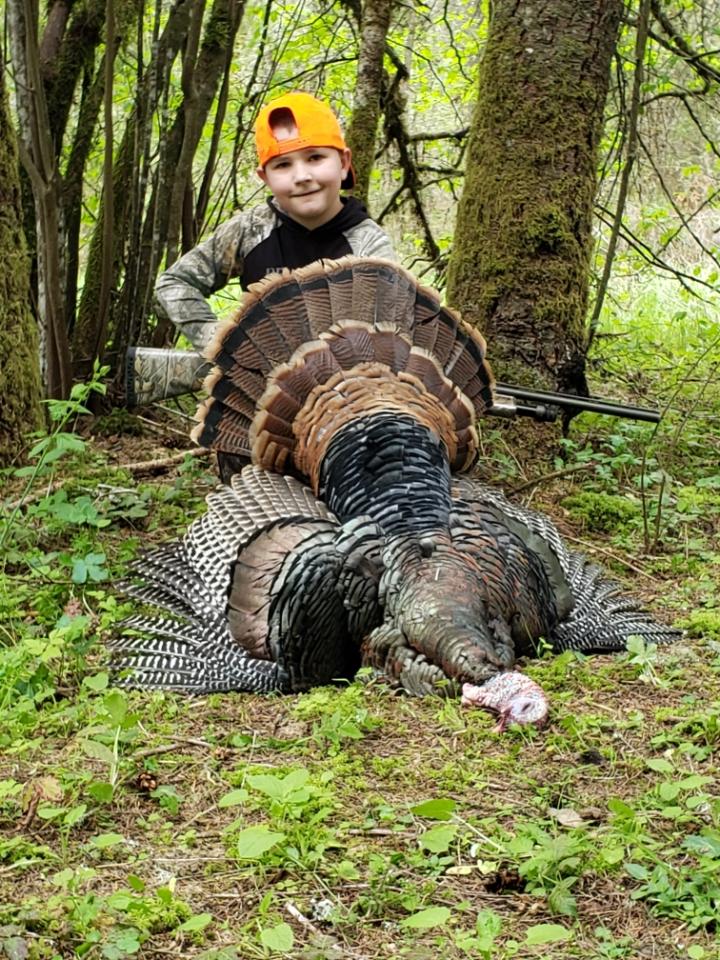
CENTRAL AREA
CROOK COUNTY
Turkeys can be found on forestland in the Ochoco, Grizzly and Maury WMU’s. Turkey numbers and distribution in the district are gradually increasing, with groups scattered throughout the national forest. Turkeys were relocated to the southern portion of the Ochoco WMU and the Eastern portion of the Maury WMU this winter. There is still snow at higher elevations and north-facing areas of the forest, and spring so far has been pretty wet, so travel may be limited. Green up is occurring below the snow line and turkeys can often be found in these areas.
Hunters should contact both the Ochoco National Forest and Prineville BLM offices for road conditions and motorized access restrictions. Motorized restrictions remain in effect year-around in the South Boundary Cooperative Travel Management Area (TMA) along the southern boundary of the Ochoco National Forest. Maps of the area are available at entry portal signs, and at ODFW and Ochoco National Forest offices in Prineville.
DESCHUTES COUNTY
Turkey populations remain low and not widely distributed throughout Deschutes County. Numbers are increasing slightly in the northern portion of the Upper Deschutes Unit and select areas of the Metolius Unit. Mild winter conditions will result in good overwinter survival. Look for turkeys on USFS and private timber company lands. Make sure to ask for permission before hunting on private lands.
JEFFERSON COUNTY
The best locations to hunt turkey in Jefferson County are in the Metolius Unit on Green Ridge from Black Butte north to the Warm Springs Reservation, and east into the juniper zone. Hunting pressure usually drops off significantly after opening week. Lower elevation roads without snow may be soft and muddy.
Increased overwinter survival and favorable spring conditions have led to an increase in turkey numbers in the Metolius Unit. Contact the Sisters Ranger District of the Deschutes National Forest for road conditions and motorized access restrictions.
SOUTH CENTRAL AREA
LAKE COUNTY
In Lake County, turkey numbers are extremely low. However, this winter the population was supplemented with nuisance turkeys relocated from private lands in Grant County to Fremont National Forest lands. Previous translocations and additional birds have made for some opportunity on public land, but due to natural dispersal many have moved away from their original release site.
Winter conditions in much of Lake County were moderate this year due to lack of snow. As a result, we expect that turkey populations have remained stable in areas of augmentation, but it still may be very difficult locating birds as they remain in isolated pockets. Turkeys are restricted to the southern portion of the county on or near national forestland along the west side of the Goose Lake Valley in the Interstate Unit.
KLAMATH COUNTY
For Klamath County, turkeys are mostly restricted to the Keno Unit. Overwinter survival and chick production were good this past year. Hunting access is good in the southern portions of the Keno Unit. Although it was a very mild winter, precipitation has made many 2-track roads and trails too muddy to be driven without causing damage to the road. As a result, cooperators involved in the Pokegema Winter Range Road Closure have elected to delay opening those gates, (gates will open April 9). Turkey releases were made this winter in the area south of Hwy 66 as well as Johnson Prairie.
This area is predominantly either open-to-hunt private timberland (Green Diamond Resource Company), or BLM land. Areas to check for turkey activity are south of Hwy 66 and west of the Klamath River Canyon to Copco Road. Turkeys can also be found north of Hwy 66 around Johnson Prairie. Hunters who take a banded turkey are asked to please contact the local ODFW district office in Klamath Falls (541-883-5732).
SOUTHEAST AREA
HARNEY COUNTY
In Harney County, turkeys are restricted to the northern portion of the county on or near national forestland. Local turkey populations have improved over the past few years with relatively mild winter conditions. However, it may take a few more years of good winter conditions for turkey populations to fully recover. Overall snowpack was near average, so snow will likely limit access to higher elevations and northern aspects early in the season.
MALHEUR COUNTY
Turkeys continue to increase in both number and range in the northern portions of Malheur County. The forest fringe habitat from Juntura to Ironside has increasing numbers of birds in recent years and good public land access in many areas. However birds are not evenly distributed, hunters will need to spend some time in the area finding places that hold birds.
NORTHEAST AREA
BAKER COUNTY
urkey numbers going into the winter were good in Baker County. Late snows in February will limit hunter access in the early part of the season. Things are just starting to green-up at lower elevations and hunters should concentrate their efforts near these areas. Hunters can improve their early season success by walking into areas that are not accessible by vehicles due to snow.
Access to forestlands in the mid to upper elevations will still be limited due to snow in April. As the season progresses and snow lines retreat, turkeys will follow. There are public land hunting opportunities on the BLM and the Wallowa-Whitman National Forest as well as the ODFW-managed Elkhorn Wildlife Area. The Pine Creek, Sumpter and Keating units all hold good numbers of birds on public land. Remember to ask for permission before hunting on private properties.
GRANT COUNTY
Turkeys are widely distributed and continue to increase throughout the county. Over-winter survival was good this year with mild winter conditions. Spring green up has started moving birds onto Forest Service lands. The late season snow that the area is currently receiving could make access difficult in the early season as some roads may could have substantial snow drifts, especially on north facial corners. Hunters should carry tire chains and snow shovels with them. During early season, some turkeys may persist on private property and hunters will need permission to hunt. Hunters have been successful in finding birds in the Middle Fork John Day River, Murderers Creek, and North Fork John Day River drainages.
Other drainages recommended for hunters who are unfamiliar with the area are Ingle Creek, Fields Creek and Deer Creek in the Murderers Creek Unit. In the Northside Unit, hunters may try Camp Creek, Pass Creek, Fox Creek, and Cottonwood (but much of Cottonwood is private), Dixie Creek or the large tracts of National Forest. In the Desolation Unit, hunters may focus in the areas of Big Creek, Mosquito Creek, Vinegar Creek or Desolation Creek.
MORROW, GILLIAM, WHEELER COUNTIES
Turkey numbers continue to improve due to increased nesting success over the last couple of years. Forest Service land and the surrounding forested habitat hold good numbers of turkeys and provide opportunity for hunters. Over-winter survival appears good again this year; however, snow levels will make access more difficult for hunters this year.
Hunters will want to target the lower elevation (mainly western) portions of the Umatilla National Forest at least until the snowpack recedes. Also target the north slopes of the Blue Mountains as well as the North Fork John Day drainage. As the snow recedes, the turkeys will continue to move upslope following the receding snow line.
UMATILLA COUNTY
Late snowfall this winter concentrated turkeys at lower elevations. However, with the recent warm temperatures turkeys are making their way to higher elevations. This year’s snowpack will limit hunter access to some of those higher elevation areas until later in the season. Over-winter survival for turkeys appears to be good this year in Umatilla County. There are good numbers of turkeys all along the front face of the Blue Mountains and they are expanding into new areas.
These areas are dominated by private land and access is sometimes difficult. However, turkeys do inhabit some public land areas as follows: central Ukiah Unit on national forestland, southern Ukiah Unit on Pearson Ridge and surrounding drainages, Umatilla National Forest lands in the eastern portion of the Heppner Unit, Mt Emily Unit on Umatilla National Forest lands on ridges below Black Mountain.
Turkeys will inhabit the low and mid-elevation areas while the snow is still present in high elevation habitats. Low elevation areas are dominated by private ownership and hunters will need permission to hunt.
UNION COUNTY
Turkeys are widely distributed throughout the county. Access to higher elevation hunting areas may prove difficult through much of May this year. Lower elevations should have decent access. Birds may use areas with residual snow cover, so these spots should be considered when scouting for new hunting locations.
Look for birds at the north end of the Grande Ronde Valley, Palmer Valley and the south end of the Catherine Creek Unit. The highest concentrations of birds will be in the west Sled Springs, Wenaha and east slopes of the Mount Emily units within Union County. The Wallowa Whitman National Forest and Hancock Timber lands both hold great turkey habitat around the edges of the Grande Ronde Valley. Hancock lands are open to the public and provide several walk-in hunting opportunities within Union County.
The Little Catherine Creek Travel Management Area provides access into road systems on the east side of the Grande Ronde valley; maps are available at the La Grande ODFW office and online.
At Ladd Marsh Wildlife Area, turkeys can be found on Glass Hill. These birds spend their time in the transition between the open fields and the dense forest feeding and traveling amongst the brush. The birds are sensitive to pressure so hunters might be successful trying slow, soft calling. Also, prime times will be the first part of season and the last, based on hunter pressure.
WALLOWA COUNTY
Turkey hunters can expect good numbers of birds in most areas of the county. Road access to high elevations is expected to be difficult, due to snowdrifts, through April. Our snow is mostly gone from low elevation areas and south-facing slopes.
Birds are beginning to scatter throughout forested areas so hunters should put in some time hiking, listening and looking for signs of turkey activity. Call for them or just listen for their calls early in the morning and late in the evening. Hunters are reminded that cooperative travel management areas are in effect in the Wenaha and Sled Springs Units.

